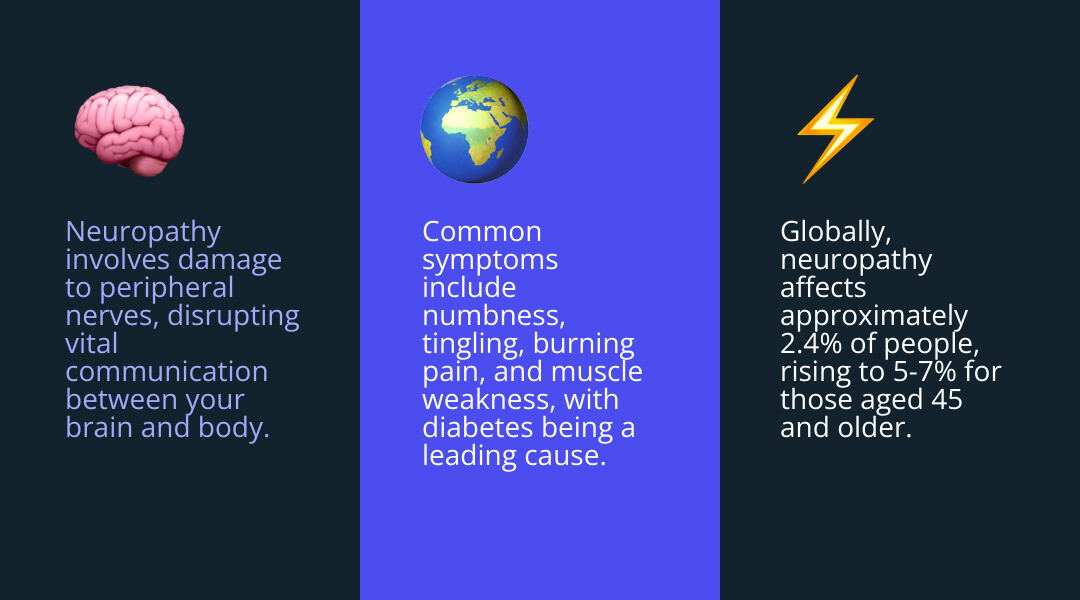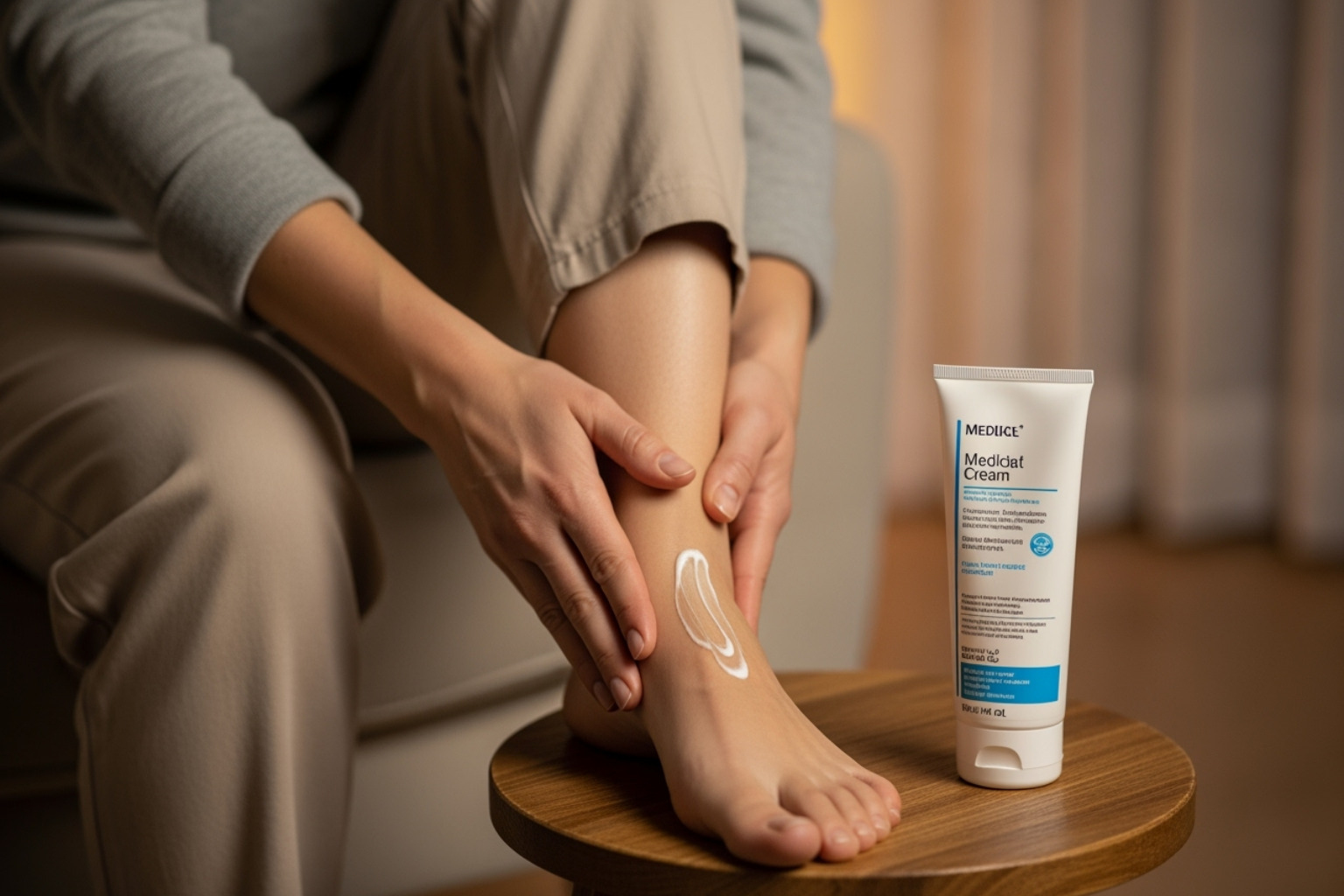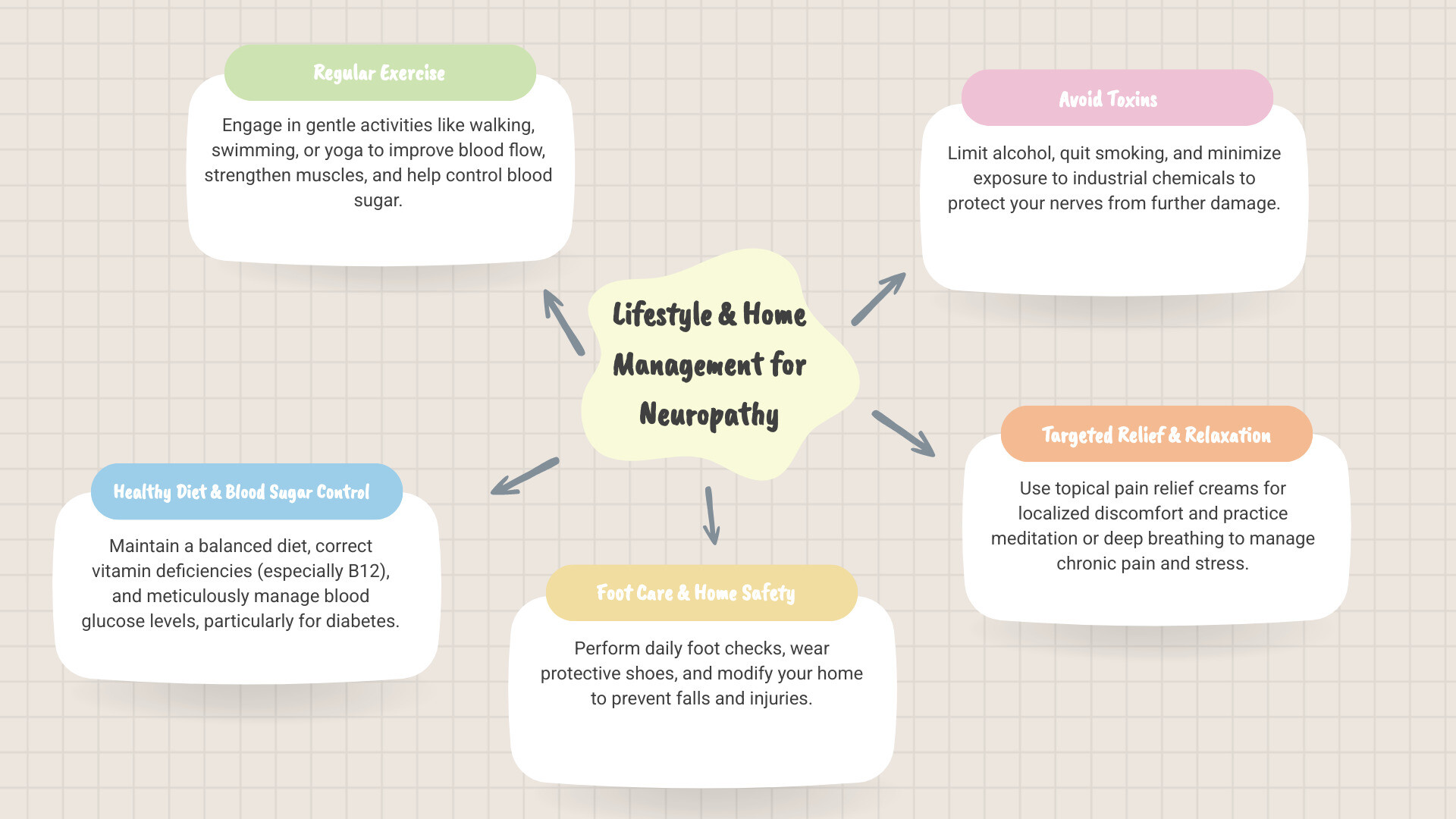Understanding Neuropathy: The Basics
Neuropathy is a condition caused by damage to the nerves outside your brain and spinal cord (the peripheral nervous system). This damage disrupts communication between your brain and body, leading to a variety of symptoms.
Here’s a quick overview:
- What it is: Damage to the peripheral nervous system.
- How common: Affects millions in the U.S. and about 2.4% of the general population, rising to 8% for those over 55.
- Key symptoms: Numbness, tingling, burning pain, muscle weakness, and poor coordination.
- Main causes: Diabetes is the leading cause, followed by injuries, autoimmune diseases, infections, and genetic factors.
- Can it be managed? Yes, by treating the underlying cause, making lifestyle changes, and using various therapies.
My name is Tony Enrico, and I've dedicated my work to helping people find relief from chronic nerve pain like neuropathy. I believe that effective, clean solutions can empower you to manage pain and improve your quality of life. This guide is designed to provide you with that essential knowledge.

Understanding Peripheral Neuropathy: What It Is and How It Feels
Your peripheral nervous system is the vast network of nerves connecting your brain and spinal cord to the rest of your body. These nerves are messengers, carrying signals that control movement, sensation, and automatic functions. Peripheral neuropathy occurs when these nerves are damaged, causing communication to break down. Signals can become lost (causing numbness), fire incorrectly (causing pain), or get distorted.
This damage often follows a "length-dependent" pattern, affecting the longest nerves first. This is why symptoms frequently begin in the toes and feet before moving upward.

What are the symptoms of neuropathy?
The symptoms of neuropathy depend on which nerves are affected. Common signs include:
- Pain: Often described as sharp, stabbing, burning, or like electric shocks. A heightened sensitivity to touch (allodynia) can make even light pressure feel painful.
- Numbness: A loss of sensation, often starting in the hands or feet, which can feel like wearing invisible gloves or socks.
- Tingling: A "pins and needles" sensation that can become constant and bothersome.
- Burning Sensation: A persistent, uncomfortable heat that seems to originate from within the nerves.
- Muscle Weakness: Difficulty gripping objects, tripping, or a general feeling of weakness. It can lead to cramps, twitching, and loss of coordination.
- Autonomic Symptoms: If nerves controlling automatic functions are damaged, you may experience heat intolerance, abnormal sweating, digestive issues, bladder problems, or dizziness from sudden drops in blood pressure.
Recognizing these symptoms early is key. If you experience unusual tingling, weakness, or pain, consult a healthcare professional. You can learn more on our page about Peripheral Neuropathy Symptoms.
Understanding the types of neuropathy
Neuropathy is classified by the type and number of nerves affected.
- Motor neuropathy affects nerves controlling muscle movement, causing weakness, cramps, and twitching.
- Sensory neuropathy damages nerves that transmit sensations like touch, temperature, and pain, leading to numbness, tingling, and burning pain.
- Autonomic neuropathy impacts nerves that manage automatic bodily functions, such as heart rate, blood pressure, and digestion.
Neuropathy can also be classified by its distribution:
- Mononeuropathy: Damage to a single nerve, like in carpal tunnel syndrome.
- Polyneuropathy: The most common form, involving damage to multiple nerves, typically symmetrically (e.g., in both feet). Diabetic neuropathy often follows this pattern.
Understanding these types helps doctors create effective treatment plans. For more on nerve disorders, explore resources on Peripheral Nerve Disorders.
The Root Causes of Neuropathy: From Diabetes to Infections
Neuropathy is often a symptom of an underlying condition. Identifying the root cause is the most effective way to manage symptoms and prevent further nerve damage. Causes can range from systemic diseases and infections to injuries and genetic factors. In up to 30% of cases, the cause cannot be identified (idiopathic neuropathy).
Diabetes: The Leading Cause
Diabetes is the most common cause of neuropathy in the U.S., affecting about 50% of people with the condition. Chronically high blood sugar levels injure nerve fibers and the small blood vessels that nourish them. This damage typically starts in the feet and legs, causing numbness, tingling, or severe Diabetic Foot Pain. Tightly controlling blood sugar is the best way to prevent or slow the progression of Diabetic neuropathy.
Autoimmune Diseases and Infections
Autoimmune disorders can cause the immune system to attack nerve tissues. Conditions like Guillain-Barré syndrome, lupus, and rheumatoid arthritis are known triggers.
Certain infections can also directly damage nerves. Key examples include:
- Lyme disease: A bacterial infection from tick bites that can cause neurological symptoms if untreated.
- Shingles: A reactivation of the chickenpox virus that targets sensory nerves, often causing intense pain.
- HIV: The virus itself or medications used to treat it can lead to neuropathy in about 30% of patients, according to Johns Hopkins Medicine.
Other Common Causes
Many other factors can contribute to nerve damage:
- Vitamin Deficiencies: A lack of essential B vitamins (B1, B6, B12, B9) and Vitamin E can impair nerve function. Conversely, excessive B6 intake can also be toxic to nerves.
- Chemotherapy-induced peripheral neuropathy (CIPN): A common side effect affecting 30-40% of cancer patients, where chemotherapy drugs damage peripheral nerves.
- Physical Injuries: Trauma from accidents, falls, or repetitive stress can directly compress or sever nerves.
- Chronic Alcohol Abuse: Alcohol is toxic to nerve tissue and often leads to nutritional deficiencies that worsen the damage.
- Hereditary Neuropathies: Genetic conditions like Charcot-Marie-Tooth disease (CMT) are passed down through families.
- Toxins: Exposure to heavy metals, industrial chemicals, and certain medications (including some antibiotics and statins) can cause nerve damage.
How Doctors Diagnose Neuropathy
Diagnosing neuropathy involves identifying the presence, extent, and cause of nerve damage. The process is methodical, starting with a detailed discussion of your symptoms, medical history, lifestyle, and family history.
This is followed by a physical and neurological exam to assess:
- Reflexes: To check nerve-muscle communication.
- Muscle strength and tone: To look for weakness or atrophy.
- Sensation: Using tools to test your ability to feel touch, vibration, and temperature.
- Balance and coordination: Observing your gait and movement.
Key Diagnostic Tests
To confirm a diagnosis and pinpoint the cause, your doctor may order specialized tests:
- Nerve Conduction Velocity (NCV) and Electromyography (EMG): These tests measure the speed and strength of electrical signals in your nerves and the electrical activity in your muscles. They are essential for diagnosing most types of neuropathy.
- Blood Tests: Used to check for underlying causes like diabetes, vitamin deficiencies, autoimmune markers, or kidney and liver issues.
- Skin Biopsy: A small skin sample is examined to measure the density of small nerve endings, which is useful for diagnosing small fiber neuropathy.
- Nerve Biopsy: In some cases, a small piece of a nerve is surgically removed and examined under a microscope for direct evidence of damage.
- Imaging Tests (MRI or CT): Can reveal structural problems like herniated discs or tumors that may be compressing nerves.
- Other Specialized Tests: Autonomic testing, genetic testing, or a spinal tap may be used to diagnose specific types of neuropathy.
Combining these results helps your healthcare team create a comprehensive treatment plan custom to your specific condition.
Managing Neuropathy: A Multifaceted Approach to Treatment
Managing neuropathy requires a comprehensive approach focused on relieving symptoms, stopping further nerve damage, and improving quality of life. This often involves a combination of medical treatments, lifestyle changes, and targeted home care.

Medical Treatments and Therapies
Medical interventions aim to manage symptoms and treat the underlying cause.
- Pain Relievers: Over-the-counter medications may help with mild pain, but prescription drugs are often needed for more severe nerve pain. These can include anti-seizure medications (like gabapentin) and certain antidepressants (like duloxetine), which are effective at calming overactive nerve signals.
- Physical Therapy: Helps improve strength, balance, and coordination. A therapist may recommend exercises, braces, or special shoes.
- Transcutaneous Electrical Nerve Stimulation (TENS): Uses mild electrical currents to help block pain signals.
- Immunosuppressive Therapy: For autoimmune neuropathies, treatments like IVIg or plasma exchange can calm the immune system's attack on nerves.
- Surgery: In some cases, surgery can relieve pressure on a nerve (as in carpal tunnel syndrome). More information can be found on resources like Peripheral Nerve Surgery.
For more strategies, see our guide on Nerve Pain Relief with Neuropasil Natural Solutions.
Lifestyle and Home Management for Neuropathy Symptoms
Daily habits play a crucial role in managing neuropathy.
- Regular Exercise: Gentle activities like walking and swimming improve blood flow, strengthen muscles, and help control blood sugar.
- Healthy Diet: A balanced diet rich in fruits, vegetables, and lean proteins provides essential nutrients for nerve health. Correcting a vitamin deficiency (especially B12) can be highly effective.
- Foot Care: If you have foot neuropathy, check your feet daily for injuries you may not feel and always wear protective, well-fitting shoes.
- Avoid Toxins: Limiting alcohol and quitting smoking are vital, as both can damage nerves and restrict blood flow.
- Topical Relief: For localized discomfort, a nerve pain relief cream can provide targeted comfort. Neuropasil creams are formulated with ingredients like cooling Menthol and soothing Aloe Vera to help manage nerve-related pains, from Sciatic Nerve Pain to general aches. Learn more about Unlock Sciatica Relief: Quick Solutions for Lasting Comfort.
- Relaxation Techniques: Meditation and deep breathing can help manage chronic pain and reduce stress.

The Future of Treatment and Research
The prognosis for neuropathy varies. If the cause is treatable, nerve damage can sometimes be halted or even reversed. For others, management focuses on preventing progression. Early diagnosis is always critical.
Exciting research is underway in several areas:
- Nerve Regeneration: Finding ways to encourage nerves to repair and regrow.
- Gene Therapy: Aiming to correct the genetic defects that cause hereditary neuropathies.
- Stem Cell Research: Exploring the use of stem cells to repair or replace damaged nerve cells.
- New Drug Development: Creating more effective medications to block pain and target nerve damage.
These efforts offer hope for better treatments in the future. You can Search for Clinical Trials to explore emerging options.
Frequently Asked Questions about Neuropathy
Navigating neuropathy can bring up many questions. Here are straightforward answers to some common concerns.
Can neuropathy be cured completely?
Whether neuropathy can be cured depends on its cause. If the underlying issue is treatable—like a vitamin deficiency or well-managed diabetes—nerve damage can often be halted, and sometimes nerves can partially heal, especially with early intervention.
For many, however, a complete cure isn't realistic. In these cases, the focus shifts to effective symptom management to prevent further damage and improve quality of life. A combination of medical treatments, lifestyle changes, and targeted topical relief can provide significant improvement.
What is the best cream for nerve pain?
Topical creams are excellent for delivering targeted relief directly to the painful area. An effective nerve pain relief cream combines powerful ingredients to soothe pain and calm irritated nerves.
Key ingredients to look for include:
- Menthol: Creates a cooling sensation that distracts the nervous system from pain signals, providing an immediate analgesic effect.
- Aloe Vera: Offers natural anti-inflammatory properties to soothe irritated skin and nerves.
- Urea: Acts as a moisturizer that helps other active ingredients penetrate the skin more effectively to reach nerve endings.
Neuropasil's nerve pain relief cream is formulated with these ingredients to provide fast-acting relief from the burning, tingling, and numbness associated with neuropathy. Many users find it effective for a range of nerve-related discomforts. You can learn more about our nerve pain relief cream.
Does walking help with neuropathy in the feet?
Yes, absolutely. Gentle exercise like walking is highly beneficial for neuropathy in the feet. It may seem counterintuitive if you have pain or numbness, but staying active offers several key advantages:
- Improves Blood Flow: Better circulation delivers more oxygen and nutrients to damaged nerves.
- Strengthens Muscles: Regular movement helps maintain muscle strength, which improves stability and balance.
- Reduces Pain: Exercise releases endorphins, the body's natural painkillers, and helps manage blood sugar levels in diabetic neuropathy.
Always start slowly, wear supportive and protective footwear, and consult your healthcare provider before beginning a new exercise routine to ensure it is safe for you.

Conclusion
Understanding neuropathy is the first step toward reclaiming your quality of life. This condition, caused by damage to the peripheral nervous system, can lead to challenging symptoms like pain, numbness, and muscle weakness. The causes are diverse, with diabetes being a primary culprit, but also including infections, injuries, and genetic factors.
Fortunately, effective management is possible. Early diagnosis through a thorough medical evaluation is key to identifying the underlying cause. A successful treatment plan often combines medical therapies with crucial lifestyle adjustments like exercise, a healthy diet, and proper foot care.
While a universal cure remains on the horizon, you can take control of your symptoms. By addressing the root cause and adopting a multifaceted management approach, you can significantly improve your daily comfort and function. For targeted, fast-acting relief from localized nerve pain, natural topical solutions can be a powerful tool in your arsenal.
Your journey with neuropathy is unique, but you are not alone. With the right knowledge, medical care, and symptom management tools, you can move forward with confidence. For more information about how our nerve pain relief creams can provide the targeted comfort you need, visit our product page.
References / Sources
This guide draws on information from trusted medical institutions and government health organizations to ensure accuracy. The factual claims and statistics presented in this article are supported by the following sources:
- National Institute of Neurological Disorders and Stroke (NINDS): Provides general information on peripheral neuropathy, including the statistic that it affects an estimated 20 million people in the U.S. Peripheral Neuropathy
- WebMD: Source for prevalence statistics, stating that neuropathy affects about 2.4% of the general population and 8% of people older than 55. Understanding Peripheral Neuropathy -- The Basics
- National Institute of Diabetes and Digestive and Kidney Diseases (NIDDK): Confirms that about 50% of people with diabetes experience nerve damage. Diabetic Neuropathy
- OHSU Brain Institute: Source for the statistic that in up to 30% of cases, the cause of neuropathy is unknown (idiopathic). Peripheral Neuropathy
-
Johns Hopkins Medicine: Provides information on various nerve disorders, surgical options, and the statistic that neuropathy affects about 30% of people with HIV.
- HIV and the Nervous System
- Peripheral Nerve Disorders
- Peripheral Nerve Surgery
- National Cancer Institute (NCI): Source for data on Chemotherapy-Induced Peripheral Neuropathy (CIPN), affecting 30-40% of patients. Nerve Problems (Peripheral Neuropathy) and Cancer Treatment
- National Institute of Allergy and Infectious Diseases (NIAID): Information on infection-related neuropathy. Lyme Disease
- Charcot-Marie-Tooth Association (CMTA): Resource for hereditary neuropathies. Charcot-Marie-Tooth Disease (CMT)
- Mayo Clinic: General information on symptoms, causes, and diagnosis. Peripheral neuropathy
- ClinicalTrials.gov: Database for finding clinical trials related to peripheral neuropathy. Search for Peripheral Neuropathy Trials
- Medical News Today: General patient information on neuropathy. Everything you need to know about neuropathy













